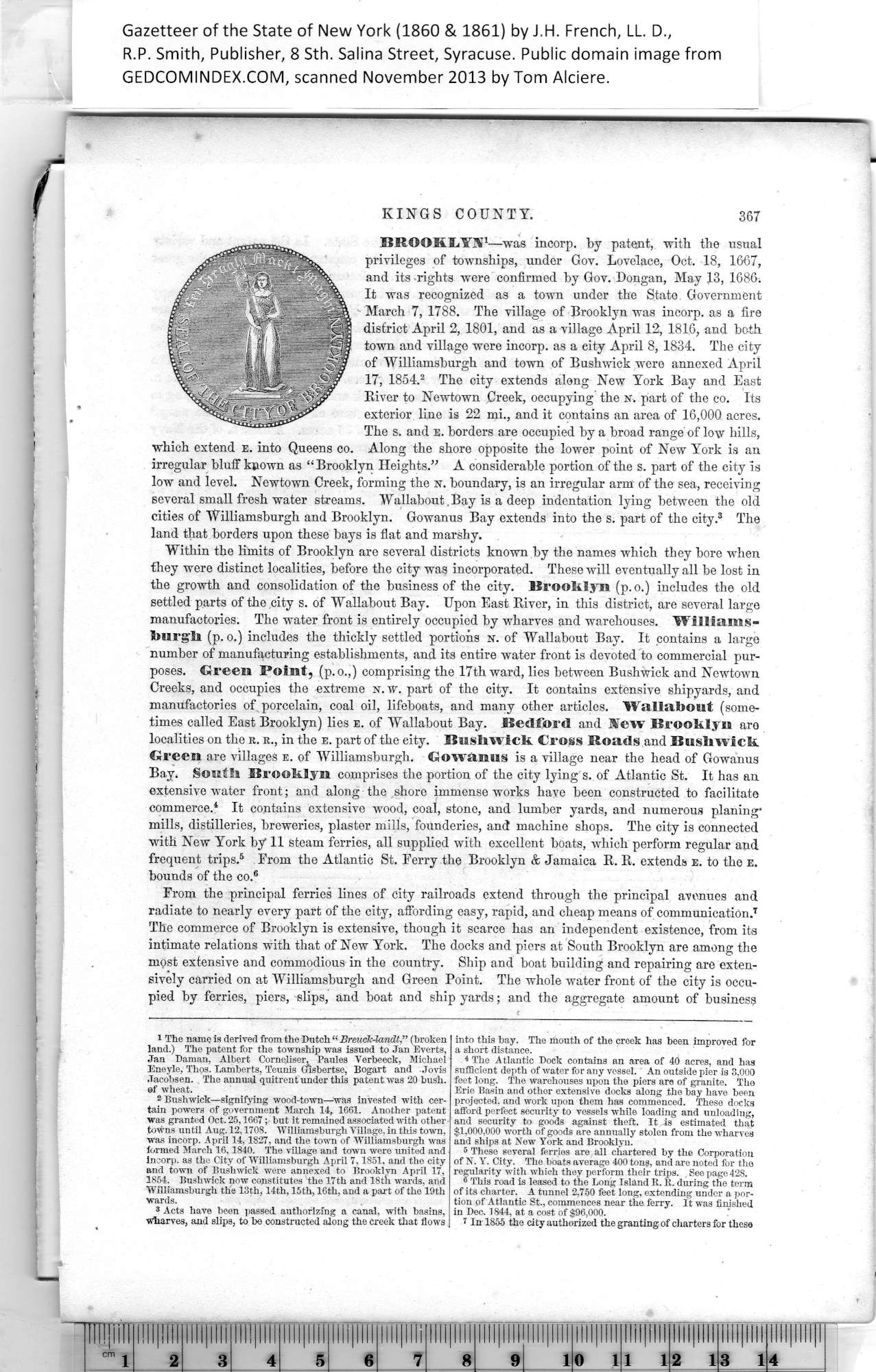|
KINGS COUNTY. 367
BROOKLYN1 —was incorp. by patent, with the usual
privileges of townships, under Gov. Lovelace, Oct. 18, 1667,
and its rights were confirmed by Gov. Dongan, May 13, 1686.
It was recognized as a town under the State Government
March 7, 1788. The village of Brooklyn was incorp. as a fire
district April 2, 1801, and as a village April 12, 1816, and both
town and village were incorp. as a eity April 8, 1834. The city
of Wiiliamsburgh and town of Bushwick were annexed April
17, 1854.2 The city extends along New York Bay and East
Biver to Newtown Creek, occupying the N. part of the co. Its
exterior line is 22 mi., and it contains an area of 16,000 acres.
The s. and e. borders are occupied by a broad range of low hills,
which extend e. into Queens co. Along the shore opposite the lower point of New York is an
irregular bluff known as “Brooklyn Heights.” A considerable portion of the s. part of the city Is
low and level. Newtown Creek, forming the n. boundary, is an irregular arm of the sea, receiving
several small fresh water streams. Wallabout.Bay is a deep indentation lying between the old
cities of Wiiliamsburgh and Brooklyn. Gowanus Bay extends into the s. part of the city.3 The
land that borders upon these bays is flat and marshy.
Within the limits of Brooklyn are several districts known by the names which they bore when
they were distinct localities, before the city was incorporated. These will eventually all be lost in
the growth and consolidation of the business of the city. Brooklyn (p.o.) includes the old
settled parts of the city s. of Wallabout Bay. Upon East River, in this district, are several large
manufactories. The water front is entirely occupied by wharves and warehouses. Willlams-
ftmrgli (p.o.) includes the thickly settled portions N. of Wallabout Bay. It contains a large
number of manufacturing establishments, and its entire water front is devoted to commercial pur¬
poses. Green Point; (p.o.,) comprising the 17th ward, lies between Bushwick and Newtown
Creeks, and occupies the extreme n.w. part of the city. It contains extensive shipyards, and
manufactories of porcelain, coal oil, lifeboats, and many other articles. Wallabout (some¬
times called East Brooklyn) lies e. of Wallabout Bay. Bedford and Mew Brooklyn aro
localities on the r. r., in the e. part of the city. Bushwick Cross Roads and Bushwick
Green are villages e. of Wiiliamsburgh. Gowanus is a village near the head of Gowanus
Bay. South Brooklyn comprises the portion of the city lying s. of Atlantic St. It has an
extensive water front; and along the shore immense works have been constructed to facilitate
commerce.3 It contains extensive wood, coal, stone, and lumber yards, and numerous planing-
mills, distilleries, breweries, plaster mills, founderies, and machine shops. The city is connected
with New York by 11 steam ferries, all supplied with excellent boats, which perform regular and
frequent trips.5 From the Atlantic St. Ferry the Brooklyn & Jamaica R. R. extends e. to the e.
bounds of the co.6
From the principal ferries lines of city railroads extend through the principal avenues and
radiate to nearly every part of the city, affording easy, rapid, and cheap means of communication.1
The commerce of Brooklyn is extensive, though it scarce has an independent existence, from its
intimate relations with that of New York. The docks and piers at South Brooklyn are among the
most extensive and commodious in the country. Ship and boat building and repairing are exten¬
sively carried on at Wiiliamsburgh and Green Point. The whole water front of the city is occu¬
pied by ferries, piers, slips, and boat and ship yards; and the aggregate amount of business
|
into this hay. The mouth of the creek has been improved for
a short distance.
4 The Atlantic Dock contains an area of 40 acres, and has
sufficient depth of water for any vessel. An outside pier is 3,000
feet long. The warehouses upon the piers are of granite. Tha
Erie Basin and other extensive docks along tho hay have been
projected, and work upon them has commenced. These docks
afford perfect security to vessels while loading and unloading,
and security to goods against theft. It is estimated that
$1,000,000 w'orth of goods are annually stolen from the wharves
and ships at New York and Brooklyn.
5 These several ferries are all chartered by the Corporation
of N. Y. City. The boats average 400 tons, and are noted for the
regularity with which they perform their trips. See page 428.
3 This road is leased to the Long Island R. R. during the term
of its charter. A tunnel 2,750 feet long, extending under a por¬
tion of Atlantic St., commences near the ferry. It 'was finished
in Dec. 1844, at a cost of $96,000.
1 In 1855 the city authorized the granting of charters for these |
1
The name is derived from the Dutch “ Breuck-landt,” (broken
land.) The patent for the township was issued to Jan Everts,
Jan Daman, Albert Corneliser, Paules Verbeeck, Michael
Eneyle, Thos. Lamberts, Teunis Gisbertse, Bogart and Jovis
Jacobsen. The annual quitrent under this patent was 20 bush,
of wheat.
2
Bushwick—signifying wood-town—was invested with cer¬
tain powers of government March 14, 1661. Another patent
was granted Oct. 25,1667; hut it remained associated with other
towns until Aug. 12,1708. Wiiliamsburgh Village, in this town,
was incorp. April 14,1827, and the town of Wiiliamsburgh was
formed March 16,1840. The village and town were united and
incorp. as the City of Wiiliamsburgh April 7,1851, and the city
and town of Bushwick were annexed to Brooklyn April 17,
1854. Bushwick now constitutes the 17th and 18th wards, and
Wiiliamsburgh the i3th, 14th, 15th, 16th, and a part of the 19th
wards.
3
wharves, and slips, to be constructed along the creek that flows
|
